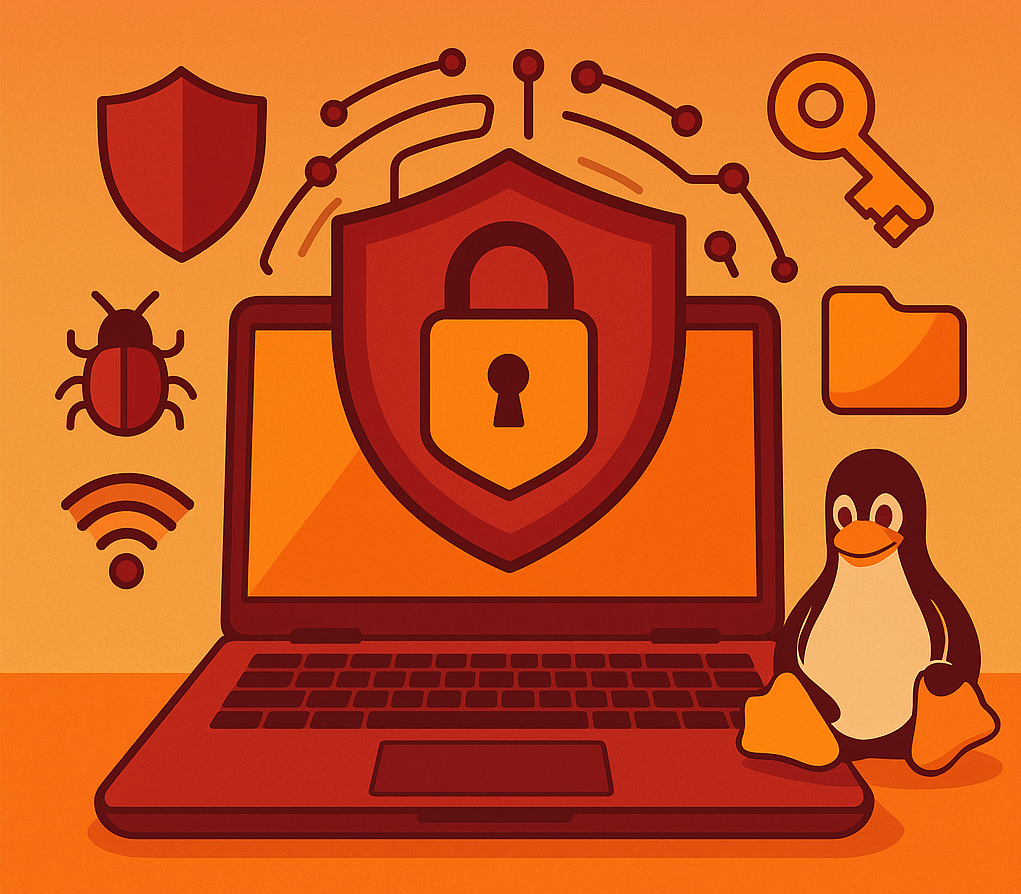Cybersecurity isn’t about achieving perfection, it’s about minimizing the attack surface, which translates into reducing risk. Every step you take from this list makes it harder for bad actors to succeed. You don’t have to do all 41 things overnight. Even if you can implement 5–10 of these items, you will dramatically boost your personal protection and lower your risk profile.
In today’s connected world, your personal computer holds more sensitive information than ever, from banking details to health records and work files. Unfortunately, this makes it a prime target for hackers, malware, and other digital threats. The good news? You don’t need to be a tech expert to secure your system!

🛡️ Antivirus & Anti-Malware Protection
- Keep antivirus updated and scan regularly: Use ClamAV
sudo freshclamto update andclamscanto scan). - Check for rootkits: Install and run
sudo apt install chkrootkit && sudo chkrootkit
🔧 Attack Surface Reduction
3. USB caution: Disable automounting with dconf-editor or manage via /etc/fstab and udisks2 rules.
4. Disable unused services: Use systemctl to disable unused or unneeded services like Bluetooth sudo systemctl disable bluetooth.
5. Keep system updated: Use sudo apt update && sudo apt upgrade or the appropriate package manager.
6. Power off/disconnect: Use shutdown now or physically unplug your Ethernet/wireless adapter when idle.
7. Remove bloatware: List and purge packages with apt list –installed and sudo apt purge.
8. Review apps: Use gnome-software or flatpak list/snap list to identify unused applications.
🔐 Authentication
9. Avoid Root account: Use a standard user account and only elevate with sudo when necessary.
10. Enable MFA: Configure MFA on web accounts (e.g., with apps like Authy or Google Authenticator); use pam_oath or pam_google_authenticator for Linux login MFA.
11. Manage permissions: Use chmod, chown, and setfacl for fine-grained control.
12. Strong, unique passwords: Use pwgen or password managers like Bitwarden or KeePassXC; set BIOS password via your system firmware settings.
📂 Backup and Recovery
13. 3-2-1 backups: Use rsync, Timeshift, or DejaDup for local and cloud backups.
14. RAID: Configure via mdadm and monitor with cat /proc/mdstat.
15. System Restore: Use Timeshift for snapshot-based restores.
👤 Safer User Behaviors
16. Screensaver/auto-lock: Enable in Settings > Privacy > Screen Lock.
17. Avoid quick unlock: Disable automatic login and use full password-based login.
18. Suspicious links: Use webmail with good phishing filters or Thunderbird + Enigmail.
19. Separate profiles: Use separate user accounts adduser or useradd for shared systems.
20. Avoid password reuse: Use password managers like KeePassXC.
21. Avoid torrents: Use legal, trusted sources only. Uninstall torrent clients.
22. Safe browsing: Use Firefox with uBlock Origin and HTTPS Everywhere.
🌐 Network Security (Ingress/Egress)
23. Close unused ports: Use ufw or iptables to block/allow specific traffic.
24. Lock browsers down: Use Firefox’s privacy settings; install NoScript or uMatrix.
25. Randomize MAC: Use macchanger or NetworkManager settings.
26. Secure SSH/RDP: Disable root login in /etc/ssh/sshd_config; use key-based auth.
27. Ad blocker: Install uBlock Origin on Firefox or Brave.
28. Firewalls: Enable and configure sudo ufw enable.
🔒 Physical Security Measures
29. Check for keyloggers: Physically inspect; use lsusb or dmesg to detect USB devices.
30. No USB charging: Use a data-blocking USB adapter or a dedicated power outlet.
31. Physical security: Use Kensington locks; avoid public exposure.
32. Secure Boot: Enable via BIOS/UEFI settings.
🕵️ Privacy Controls
33. VPN: Use Mullvad, ProtonVPN, or OpenVPN setup with NetworkManager.
34. Cover webcam/mic: Use a physical cover and disable mic in alsamixer or system settings.
35. Disable smart assistants: Not common on Linux but ensure no assistant services (like mycroft) are running.
36. Avoid linking OS to accounts: Use local Linux user accounts only.
37. Disk encryption: Use LUKS during setup or encrypt existing partitions with cryptsetup.
38. Cloud data: Use encrypted sync tools like Cryptomator.
39. Limit sharing: Disable Bluetooth and Samba/NFS when not in use.
⚙️ Proactive Defense
40. Canary Tokens: Generate at canarytokens.org and monitor file/folder access.
41. File hashing: Use sha256sum or md5sum to verify downloads.
Stay vigilant, stay curious, and remember: the biggest security risk is often you—but that also makes you the best line of defense!

Leave a Reply
You must be logged in to post a comment.